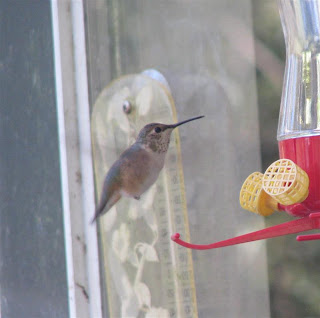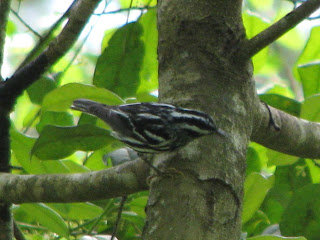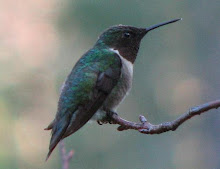
On November 29th we were elated when we saw a hummingbird drinking from a feeder near our front porch. I knew it had been a couple of weeks since I changed the sugar water in the feeder, so I quickly made some fresh juice and filled up 3 feeders. The next day we saw the hummer again, but only for a second.
 A few days later, I saw the hummingbird drinking from a patch of winter shrimp plant that was growing in a protected spot near the house. It looked like some kind of Selasphorus, probably a Rufous, but I couldn't be sure of more since I didn't have binoculars with me.
A few days later, I saw the hummingbird drinking from a patch of winter shrimp plant that was growing in a protected spot near the house. It looked like some kind of Selasphorus, probably a Rufous, but I couldn't be sure of more since I didn't have binoculars with me.Today I finally was able to take some pictures of it. I sent some of the photos to our friend and local hummingbird bander, Linda Beall. She said that it looks like an immature female Rufous, but not to rule out an Allen's.
In Louisiana, any hummingbird observed after November 15th is considered a "winter hummingbird". Each sighting is reported to a local hummingbird bander and if the property owner wishes, the hummingbird is captured and a numbered band is placed on its leg. We are blessed with two expert licensed banders here in the New Orleans / North Shore area. Linda Beall handles most of the activity here on the northshore and Nancy Newfield (author of many publications) bands on the south shore and some places here on the north.
It has been at least 2 years since we hosted a winter hummingbird in our habitat here on the Tchefuncte River in South Louisiana. We look forward to this little western visitor brightening those dull winter days with its "ticks" and "whirs" as it makes its way around the garden.
For more information about winter hummingbirds, check out the following sites:
Banding a Hummingbird
Winged Jewels of Winter
Hummingbirds.net
Linda Beall's page
Winter Hummingbirds of Southwestern Louisiana
Cornell Project Feeder Watch - Hummingbirds in Winter







